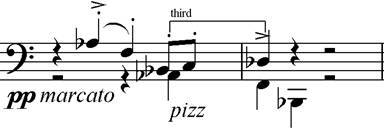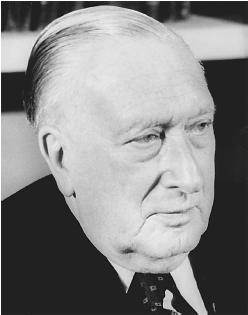Sir William Walton (1902-1983)
Born March 29, 1902, in Oldham, Lancashire
Died March 8 1983, on the Island of Ischia, Italy
Symphony No. 1
Composed 1932-1935
First Performances:
First three movements only:
3 December 1934. Queen’s Hall, London. London Symphony Orchestra, Sir Hamilton Harty conductor.
First complete performance:
6 November 1935. Queen’s Hall, London. BBC Symphony Orchestra, Sir Hamilton Harty conductor.
Instrumentation: 2 flutes (second doubling piccolo), 2 oboes, 2 clarinets in B-flat (doubling clarinets in A), 2 bassoons, 4 horns in F, 3 trumpets in C, 3 trombones, tuba, 2 timpani, 2 percussion (Percussion #1: cymbals, snare drum, Percussion #2: tam-tam) and strings
William Walton won a scholarship at the age of ten to the Choir School of Christ Church at Oxford. Though he did not receive a degree from Oxford he did met Edith, Osbert and Sacheverrell Sitwell, with whom he lived in Chelsea for ten years following his studies. This association was very fruitful, opening many doors for the young composer. An early compositional success was Façade, “an entertainment” set to Edith Sitwell’s poetry.
The composition of his Symphony No. 1 was begun in the summer of 1932 and spanned four years with several interruptions. This was the same period as his turbulent partnership with Baroness Imma Doernberg (the dedicatee of the symphony) with whom Walton lived from around 1930.
It has been more than suggested that the First Symphony is a chronicle of that relationship, with the rough and stormy rhythms of the first movement, malice of the second movement and the sadness of the third. After the end of this relationship Walton took up a new romance with Lady Alice Wimbourne, and presumably hence the reason for the stark contrast in character of the fourth movement as compared with the other three. When asked for an explanation of why the mood and character of the fourth movement was so different, a close friend of Walton’s replied, “Willie changed girlfriends between movements.”
For the work’s première on December 3, 1934 by the London Symphony Orchestra, conducted by Sir Hamilton Harty, only the first three movements were ready. The fourth movement was completed eight months later. The première of the complete work took place on November 6, 1935 with the BBC Symphony Orchestra once again conducted by Harty. The score was then revised for publication in 1936, and again in 1951.
Among Walton’s works are two marches, Crown Imperial in 1937 for the coronation of King George VI, and Orb and Sceptre
, in 1953 for the coronation of Queen Elizabeth II. He was also a successful film composer, scoring three Olivier films – Henry V
, Hamlet
and Richard III
and spending most of the 1940s writing film music. Walton also has an acting credit as King Friedrich August II of Saxony in Tony Palmer’s biopic Wagner
.
Walton was knighted in 1951 and received the Queen’s Order of Merit in 1971.
The symphony is in four movements:
I. Allegro assai
II. Presto con malizia
III. Andante con malinconia
IV. Maestoso – Allegro, brioso ed ardentemente – Vivacissimo – Maestoso
First Movement
The first movement, marked Allegro assai, is constructed organically and introduces several motifs at the outset from which the rest of the work grows. The movement begins with portentous long sustained notes in the horns and timpani forming the fundamental or “Ur” chord that will be the tonal basis for the entire symphony. While having their origin much earlier, the sound of building a tonal center around a chord in this fashion is generally attributed to the style and harmonic language of Sibelius.
[wpaudio url=”http://genedelisa.com/wordpress/wp-content/uploads/mp3/2007/03/walton1/ex01.mp3″ text=”Play” dl=”0″]
Under this sustained chord the second violins begin a rhythmic ostinato formed from the first two pitches – an interval of a fifth – from the opening chord.
[wpaudio url=”http://genedelisa.com/wordpress/wp-content/uploads/mp3/2007/03/walton1/ex02.mp3″ text=”Play” dl=”0″]
The ‘celli play the pitches of the opening chord in reverse order (Ab, F, Bb, skipping the G) which is immediately echoed by the basses. The ‘celli continue briefly with a 3 note motif based on the intervals of the last 3 notes of the opening:
Example 3. Opening with three note minor motif (marked “third”)

Walton spins this last motif out into a theme later in this movement and also in the fourth movement.
As soon as the ‘celli and basses finish, a solo oboe enters with a sustained melody. The rhythmic iamb – short then longer – introduced here is developed throughout the work (the ending of this movement is also a slight variant on this motif)
and its consequent phrase which ends again with the rhythmic motif from the first phrase, also contains melodic intervals that become important throughout the work
[wpaudio url=”http://genedelisa.com/wordpress/wp-content/uploads/mp3/2007/03/walton1/ex0506.mp3″ text=”Play” dl=”0″]
Under this melody in the oboe, the bassoon enters echoing the pitches from the very beginning, this time as a melody instead of a slowly stacked chord:
Almost everything that follows is based in some way on these materials.
In the middle of the development a new soaring melody is introduced by the lower strings. This is the first time we hear a major seventh (one half-step shy of a complete octave) which also becomes integral to a theme in the third movement.
Example 7. Soaring seventh (strings)

[wpaudio url=”http://genedelisa.com/wordpress/wp-content/uploads/mp3/2007/03/walton1/ex07SoaringSevenths.mp3″ text=”Play” dl=”0″]
A new theme is introduced by the violins, having formed from three notes of the cello melody (see above) and ends with the inflection borrowed from the end of the opening melody played by the oboe. The rhythmic cell with which this begins will be developed extensively. Again, a remarkably similar theme appears in the finale.
Example 8. Violins final theme

[wpaudio url=”http://genedelisa.com/wordpress/wp-content/uploads/mp3/2007/03/walton1/ex08.mp3″ text=”Play” dl=”0″]
The movement builds to a massive climax with the horns playing the soaring seventh and pedal points anchoring the tonality amidst the mounting harmonic pressure. Alternations with the final theme lead to unison chords that are then interrupted by reprises of several motifs. The movement ends in an exultant coda, with the strings repeating the agitated fifths punctuated by rhythmic Bb minor chords in the winds.
Second movement
The second movement is in triple meter, but is neither a scherzo nor a minuet. It is marked Presto con malizia (with malice). As mentioned previously, it has been suggested that the bitter bile vented in this movement is a reflection of Walton’s bitter parting with Baroness Imma Doernberg. The movement opens with melodic cells outlining a minor third:
[wpaudio url=”http://genedelisa.com/wordpress/wp-content/uploads/mp3/2007/03/walton1/ex09.mp3″ text=”Play” dl=”0″]
Rhythmically energetic melodic fragments over pedal points are tossed between the cellos and bassoons until a more complete theme emerges in the violins which is later echoed by the winds:
[wpaudio url=”http://genedelisa.com/wordpress/wp-content/uploads/mp3/2007/03/walton1/ex10.mp3″ text=”Play” dl=”0″]
A brief suspension of rhythmic activity suggests the beginning of a calm middle section but it is short lived, introducing new material.
[wpaudio url=”http://genedelisa.com/wordpress/wp-content/uploads/mp3/2007/03/walton1/ex11.mp3″ text=”Play” dl=”0″]
A climax is reached which introduces a new syncopated rhythmic cell:
[wpaudio url=”http://genedelisa.com/wordpress/wp-content/uploads/mp3/2007/03/walton1/ex12.mp3″ text=”Play” dl=”0″]
The movement seems to end with a bang; but no. There is a pause and then Walton brings the movement to a close with one final diatribe unleashed before a door slams to bring the movement to a final end.
Third movement
Walton, having vented his spleen in the second con malizia movement, settles things down into a quietly ruminating movement. A melancholy flute solo lamentingly opens the third movement over a unison C# (this melody was originally intended to be the first movement’s allegro theme).
[wpaudio url=”http://genedelisa.com/wordpress/wp-content/uploads/mp3/2007/03/walton1/ex13.mp3″ text=”Play” dl=”0″]
A solo clarinet briefly picks up this melody and a dialogue begins between the woodwinds:
[wpaudio url=”http://genedelisa.com/wordpress/wp-content/uploads/mp3/2007/03/walton1/ex14.mp3″ text=”Play” dl=”0″]
This melody evolves into a unison string theme, eventually leading to a climax:
[wpaudio url=”http://genedelisa.com/wordpress/wp-content/uploads/mp3/2007/03/walton1/ex15.mp3″ text=”Play” dl=”0″]
Near the end of the movement the music builds to a passionate climax, then ends quietly with the flute echoing its opening melody over a sustained C# in the strings.
Finale
The Finale sweeps aside all traces of melancholy with a broad majestic fanfare-like orchestral tutti, rivaling any heroic theme including Strauss’s Don Juan
[wpaudio url=”http://genedelisa.com/wordpress/wp-content/uploads/mp3/2007/03/walton1/ex16.mp3″ text=”Play” dl=”0″]
A new optimism prevails. The tempo picks up with a lively theme that contains an old rhythmic friend along with the now familiar three note motif.
[wpaudio url=”http://genedelisa.com/wordpress/wp-content/uploads/mp3/2007/03/walton1/ex17.mp3″ text=”Play” dl=”0″]
Walton’s affinity to Hindemith has been hinted at during the symphony but is nowhere more clearly displayed than a contrapuntal fugato section containing consecutive melodic fourths – first heard as a bass ostinato in the first movement and again in the flute theme in the third movement – and the minor third melodic inflection that would fit seamlessly into Mathis der Maler (which will be performed in next season’s PSO subscription concerts)
[wpaudio url=”http://genedelisa.com/wordpress/wp-content/uploads/mp3/2007/03/walton1/ex18.mp3″ text=”Play” dl=”0″]
with the middle of the fugato containing a slower calmer section.
[wpaudio url=”http://genedelisa.com/wordpress/wp-content/uploads/mp3/2007/03/walton1/ex19.mp3″ text=”Play” dl=”0″]
The motivic intervals of consecutive fourths (B to E, E to A, etc.) once again infuse new life and the fugato builds to a climax, with the brass repeating a motif from the opening fanfare. A short pause indicates a complete change of mood with a section marked Vivacissimo. Herein is a dialogue between the strings and the woodwinds using fragmented and transformed material from the opening fanfare.
The string voicing in this section is one of Walton’s signatures, reminiscent of works such as Crown Imperial.
The theme from the middle of the fugato returns, followed by a variation of the main fugato theme, Agitato. The texture gradually thickens; fragments of the other themes are introduced contrapuntally followed by the brass repeating the consecutive fourths leading to the movement’s Hohepunkt (high-point) adding percussion for the first time in the symphony.
The Finale comes to an apparent end with a reprise of the opening Maestoso fanfare – but it quiets down again with a haunting trumpet solo (reminiscent of “Taps”) constructed from previously heard material. The fanfare returns once again, this time for the final rousing conclusion descended directly from The Pines of Rome (composed in 1924). Final punctuation by the entire orchestra brings us full circle back to the rhythmic thrust of the opening movement, bringing this remarkable symphony to its close.
Resources
[amazon template=iframe image&asin=B00000220Z][amazon template=iframe image&asin=B00000IYN3][amazon template=iframe image&asin=0780021320][amazon template=iframe image&asin=0780021312][amazon template=iframe image&asin=B001WLMONW][amazon template=iframe image&asin=B0007TFHJS][amazon template=iframe image&asin=B00003WGO0][amazon template=iframe image&asin=B000002RUM][amazon template=iframe image&asin=B000003FQJ]
















